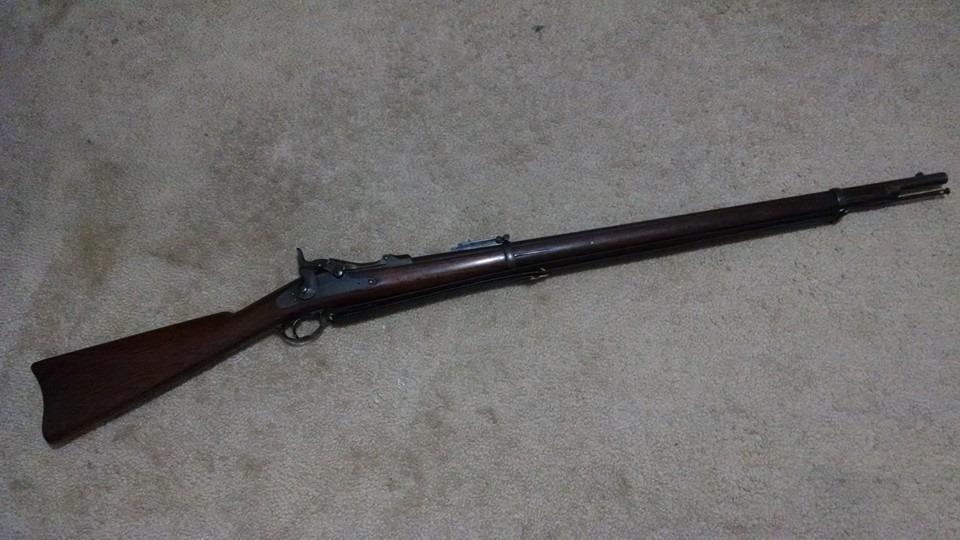
45-caliber cartridge, for which the guns were chambered, employed the Benet internal priming system and a drawn case with heavy copper content. Though several modifications were made in 1879, the Springfield Trapdoor carbine was still considered a Model 1873 and is so marked. The gun was offered in rifle, cadet rifle and carbine versions. Many of the parts were the same as those of the 1870 models, so Springfield was able to use some of the tooling for components on the older guns. Also unlike the earlier guns, it was not finished bright but had blued metal parts with a case-hardened tang and breech and black oil-quenched breechblock. Unlike its predecessors, it was not made from altered muskets but was fabricated completely from new. In 1873, a new model of Springfield Trapdoor carbine (so named because of the appearance of the breechblock) was introduced. 45 or 11mm loads, and it was finally decided that Uncle Sam should follow suit. Most Europeans were adopting "small-bore". 45 caliber was ballistically a better choice. martial arms today.Įven during the heyday of the. Only 341 of these guns were made, making them among the rarest and most desirable of U.S. It, too, used bits and pieces of Civil War muskets, but the barrel was shortened to 22 inches, the half stock fitted with only a single barrelband and a bar and ring attached to the left side of the stock opposite the lock to enable the use of a carbine sling. In 1870 the first Springfield Trapdoor carbine version of the Allin conversion appeared. The carbine wasn't more accurate, of course - the sight radius just allowed more graduations. The carbine rear sight was graduated to 1,300 yards - 100 yards more than the rifle.
#1873 springfield trapdoor 45 70 value mods#
Other mods involved a new long-range rear sight and larger cam latch. It was decided to shorten the gun's barrel and to adopt an en bloc receiver that could be screwed onto the rear of the barrel. The extractor still left something to be desired, and a new version was designed that involved a spring-loaded claw set into the receiver at the hinge of the breechblock. 50-70.Įven though the 1866 was considered a successful arm, some modifications were deemed to be in order. In 1867 a shorter Cadet Rifle appeared but still no cavalry carbines - that role being handled by the thousands of Spencer repeaters still in the system and Sharps percussion carbines converted to. The block itself was also slightly modified by employing coil springs for both the firing pin and latch.ĭubbed the Model 1866, 25,000 of these rifles were turned out at Springfield using Model 1863 rifle-muskets as platforms. Too, the old rack-and-pinion extractor was found to be lacking, and a new ejector, which involved a small spring-loaded stud set in the breech just behind the chamber, was adopted. 58 rimfire and gave greater range and accuracy, though the muzzle energy was about the same (1,488 ft-lbs).Ī lighter carbine load featuring a 400-grain bullet and 45 to 50 grains of black powder was also issued, and, as might be expected, the velocity and muzzle energy were somewhat reduced. This loading upped the velocity by 100 fps (1,260 fps) over that of the. 50 caliber to handle a new centerfire cartridge with a 450-grain lead bullet backed by 70 grains of black powder.

The original muzzleloading barrels were sleeved with a liner of. The improved extractor, which first appeared in 1873, was accused of ripping off cartridge case heads and sometimes blamed for Custer's loss at Little Big Horn.


Because of this, even the rear sight didn't have to be changed. 58-caliber copper rimfire cartridge that approximated the ballistics of the original muzzleloader's paper cartridge. The system was adopted in 1865, chambering a. These were honeyed words to penurious ordnance officials. All that is necessary is to cut away the barrel on the top at the breech and add the block and shell extractor, cut the recess in the breech-screw and modify the hammer. Allin explained: "It is particularly adapted to the alteration of the Springfield rifle-musket (or any other), as it can be done without changing the features of the musket or without throwing away any of its parts. Fast, slick and easy.Īs well as being relatively efficient, the conversion allowed the maximum use of original parts. Upon reopening the block, a rather complicated rack-and-pinion extractor ejected the spent case. The block was then closed, the hammer put on full-cock, and the rifle aimed and fired.


 0 kommentar(er)
0 kommentar(er)
